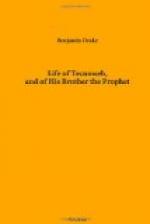In the latter part of March, intelligence reached this post that Proctor had issued a general order for assembling the Canadian militia at Sandwich, on the 7th of April, to unite in an expedition against fort Meigs. This information gave a fresh impulse to the efforts then making to render the fort, which was still in an unfinished state, as strong as possible. On the 8th of April, colonel Ball arrived with two hundred dragoons; and on the 12th general Harrison reached the fort with three hundred men from the posts on the Auglaize and St. Mary’s. Vigorous preparations were now made for the anticipated siege. On the 19th, a scouting party returned from the river Raisin, with three Frenchmen, who stated that the British were still making arrangements for an attack on this post; and were assembling a very large Indian force. They informed general Harrison that Tecumseh and the Prophet had reached Sandwich, with about six hundred Indians, collected in the country between lake Michigan and the Wabash. This intelligence removed the apprehension entertained by the general, that the Indians intended to fall upon the posts in his rear, while Proctor should attack fort Meigs. On the 26th, the advance of the enemy was discovered at the mouth of the bay; and on the 28th, the British and Indian forces were found to be within a few miles of the fort. At this time, only a part of the troops destined for the defence of the place, had arrived; but the remainder, under the command of general Green Clay, of Kentucky, were daily expected. So soon as the fort was actually invested by the Indians, an express was sent by the commander-in-chief, to inform general Clay of the fact, and direct his subsequent movements. This dangerous enterprise—for the Indians were already in considerable numbers around the fort—was undertaken and successfully executed by captain William Oliver,[A] a gallant young officer belonging to the commissary’s department, who, to a familiar acquaintance with the geography of the country, united much knowledge of Indian warfare. Attended by a white man and a Delaware Indian, Oliver traversed the country to fort Findlay, thence to fort Amanda, and finally met with general Clay at fort Winchester, on the 2d of May, and communicated to him general Harrison’s instructions.
[Footnote A: Now Major William Oliver, of Cincinnati. It is but an act of justice to this gentleman to state that, for the voluntary performance of this service, he refused all pecuniary compensation. General Harrison subsequently, in a letter to major Oliver, in relation to this service, says, “To prevent the possibility of these orders coming to the knowledge of the enemy, they could not be committed to writing, but must be communicated verbally, by a confidential officer. The selection of one suited to the performance of this important trust was a matter of no little difficulty. To the qualities of undoubted patriotism, moral firmness, as well as active courage, sagacity




